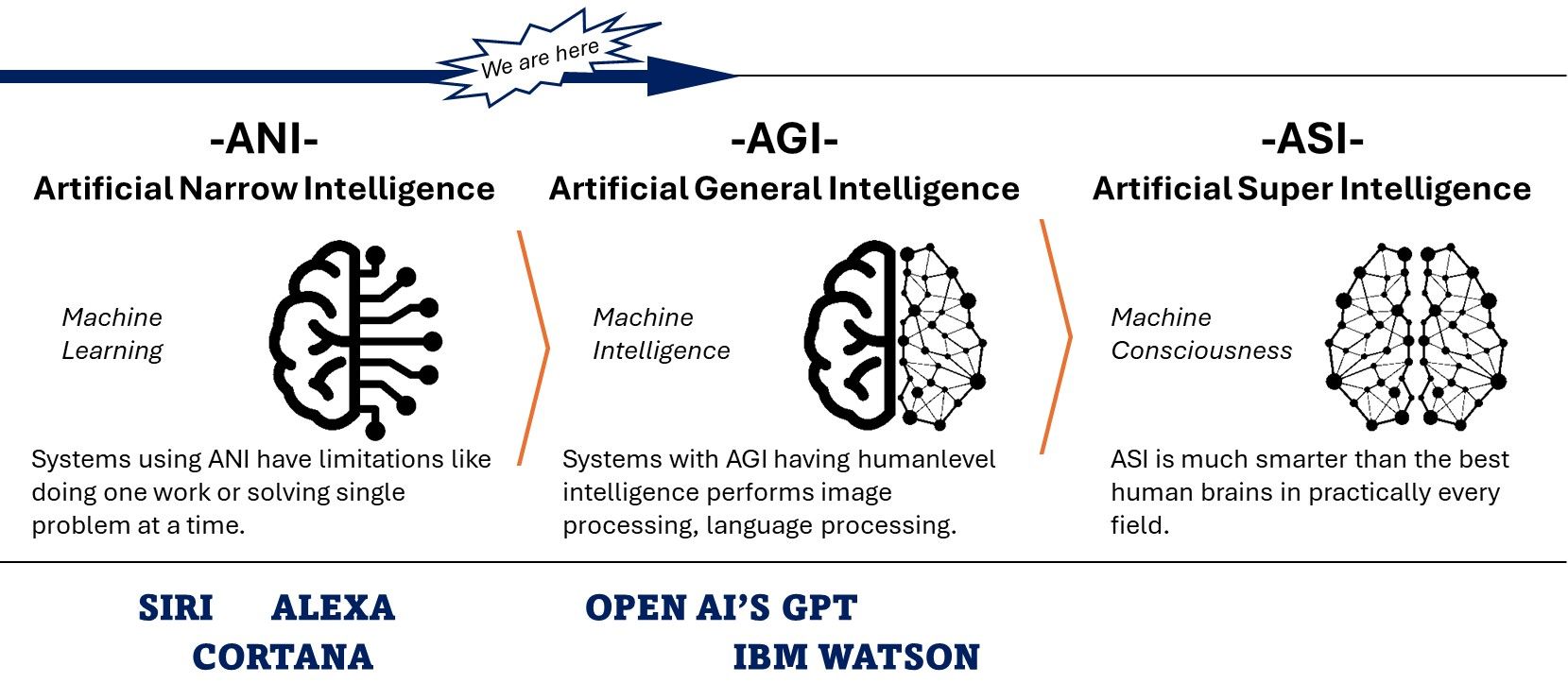AI is actually a very broad field – incorporating the likes of automation, machine learning, natural language processing (NLP), large language models (LLM), and generative pre-trained transformers (GPT) – but in tracing its journey we can divide AI into three broad types – artificial narrow intelligence (ANI), artificial general intelligence (AGI), and artificial super intelligence (ASI).

Artificial Narrow Intelligence (ANI) 特化型人工知能:
Artificial Narrow Intelligence refers to AI systems that are designed to perform specific tasks or functions with a high level of proficiency. ANI systems are created to excel in a particular domain or solve a specific problem but lack the ability to transfer their knowledge to other areas. They focus on narrow, well-defined tasks and operate within a limited scope.
- 2010s. Apple’s Siri, Google’s Google Now and Microsoft’s Cortana were launched as smartphone apps that used natural language to help users, and also includes image recognition systems, recommendation algorithms, and chatbots.
Artificial General Intelligence (AGI) 汎用人工知能:
Artificial General Intelligence refers to AI systems that possess human-level cognitive abilities across various domains. AGI aims to replicate human intelligence and exhibit a wide range of intellectual capabilities, including learning, reasoning, problem-solving, and understanding natural language. Unlike ANI, AGI systems have the potential for transfer learning, meaning they can apply knowledge from one domain to another and adapt to new situations. AGI remains an active area of research and development, and creating a true AGI is a significant challenge that has yet to be fully achieved.
- 2020s. ChatGPT becomes ubiquitous worldwide, leading to a surge in hype around AI and heightened discourse around the opportunities – and risks – it presents.
Artificial Super Intelligence (ASI) 人工超知能:
Artificial Super Intelligence refers to AI systems that surpass human intelligence in virtually every aspect. ASI is an advanced form of AI that would possess cognitive abilities far beyond what any human mind can comprehend. It would exhibit not only a greater capacity for learning and problem-solving but also a profound understanding of complex systems, surpassing human capabilities in almost every domain. The potential implications and impact of ASI are still largely speculative, as it is a hypothetical concept and no ASI systems currently exist. However, some researchers have expressed concerns about the potential risks associated with creating a superintelligent system that could outperform humans in all intellectual tasks.

Differences Between ANI, AGI, and ASI
while ANI has already been integrated into daily life, AGI and ASI holds potential for the future. Despite commonalities, significant distinctions exist among these three categories. Overall, ANI concentrates on a specific task and is limited in solving unfamiliar problems. In contrast, AGI exhibits human-like cognitive capabilities, enabling it to handle a broad range of tasks, while ASI surpasses human intelligence. When it comes to the AI model, ANI depends on pre-defined behavior models. AGI acquires knowledge from its environment and autonomously responds, while ASI attains self-awareness through independent learning. Regarding data processing, ANI processes data through machine learning, natural language processing, deep learning, and artificial neural networks. AGI employs enhanced iterations of these technologies, while ASI may draw inspiration from the human brain to interpret emotions and experiences. As AI becomes a part of our daily lives, it’s important to know the differences between the types: ANI is what we have now, with specific use cases. AGI and ASI holds promises and challenges for tomorrow. Each type of AI has special features that will influence technology in the future.
As ANI reaches its peak, the emergence of AGI and ASI brings exciting possibilities and challenges. Understanding these AI types is important as they increasingly become vital to our lives.
By the way, HAKOVO's Tariff Clarification engine is powered by machine learning algorithms and Natural Language Processing (NLP), our Smartariff’s search engine automates the process of identifying HS codes based on product descriptions.



